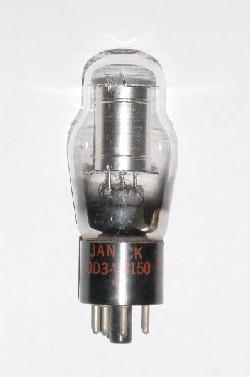| Current (mA) | Voltage (V) |
| 5.0 | 147.6 |
| 7.5 | 147.7 |
| 10.0 | 147.7 |
| 12.5 | 147.8 |
| 15.0 | 147.9 |
| 17.5 | 148.3 |
| 20.0 | 148.7 |
| 25.0 | 149.7 |
| 30.0 | 150.9 |
| 35.0 | 152.0 |
| 40.0 | 153.0 |

This page is under construction. At present only voltage regulator tubes are mentioned. More details will arrive here soon ....
Voltage Regulator (or VR) valves are ingenious devices designed to maintain a constant voltage across their terminals over a range of currents.
Such valves have a cold cathode and contain gases at low pressure rather than the conventional high vacuum normally used in amplifying valves. The internal gasses are deliberately chosen to ionise (conduct) at a particular predefined voltage.
Regulator tubes are fundamentally 2 terminal devices but some specific types have a third electrode that is connected (via a resistor) to a high voltage point and acts as a starting electrode.
Common regulator valves provide regulation for voltages between about 75 and 150 volts. Higher voltages are possible by connecting devices in series.
The internal electrode design of voltage regulator valves is asymmetrical and they are polarised devices. Your author has observed them glow when connected either way round, albeit probably with reduced lifetime and/or regulation when connected the 'wrong' way.
The very common neon type power indicator is a gas discharge tube and will exhibit a relatively constant voltage characteristic once ionised.
Gas discharge tubes require some stimulus to initiate the ionisation process. Data sheets for common type listed below specify a certain level of incident light is require to ensure ignition. Some older military parts have internal radioactive! sources permitting operation in total darkness.
These valves are potentially highly dangerous and professional help should be sought if they are identified. These should be marked with the normal triangular radioactivity symbol.
Regulator tubes are characterised by an operating voltage, an ignition voltage (about 10-30 volts higher than the operating voltage) and a range of operating currents.
The combination of a resistor to a higher voltage point, a gas discharge tube and a parallel capacitor can form a 'relaxation oscillator'. This is an often demonstrated experiment with a neon tube but isn't recommended if you are trying to provide a stable power supply! The data sheets I looked at all specified a maximum decoupling capacitance to avoid the relaxation oscillator problem.
Below is a small (and not definitive) table showing the characteristics of 6 common types. The larger octal based types will take up to 40 mA although often operation will be at a lower current.
| part number |
base type |
nominal voltage |
regulation voltage |
ignition voltage |
current range (mA) |
| 0D3 VR150 VT-139 |
Octal | 150 | 4 | 160 | 5 - 40 |
| 0A2 150C2 |
7 pin | 150 | 5 | 165 | 3 - 30 |
| 0C3 VR105 |
Octal | 108 | 2 | 115 | 5 - 40 |
| 0B2 108C1 |
7 pin | 108 | 1 | 115 | 5 - 30 |
| 85A2 | 7 pin | 85 | 4 | 115 | 1 - 10 |
| 0A3 VR75 |
Octal | 75 | 5 | 100 | 5 - 40 |
When operating, voltage regulator tubes emit a pleasant coloured glow; orange for lower voltage types (less than 100 volts) and pale purple for the higher voltage types.
Some of the 7 pin sub miniature types I have (specifically the 150B2 and 85A2) are internally silvered to minimise the amount of light radiated but are still visibly illuminated when on.
Recently I purchased a box of old octal based valves, most unboxed and some used. In amongst these were about 10 VR tubes; some VR150s, VR105s and a VR75.
I previously heard that old VR tubes can be way out of specification and after testing some of my batch I can confirm this. About half the VR105 tubes stabilised at about 120-130 volts although their regulation was still good.
The performance of one of the VR150 tubes that did stand the test of time better is shown in a table below.
|
 |
The modern 'equivalent' to a gas discharge tube is the Zener diode - smaller but definitely not as pleasing to look at :)